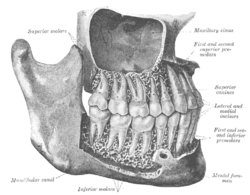Gomphosis
| Gomphosis | |
|---|---|
 The permanent teeth, viewed from the right. | |
| Details | |
| Identifiers | |
| Latin | syndesmosis dentoalveolaris |
| TA |
A03.0.00.006 A03.1.03.001 |
| FMA | 7495 |
A gomphosis, also known as a dentoalveolar syndesmosis,[1] is a joint that binds the teeth to bony teeth sockets in the maxillary bone and mandible. The fibrous connection between a tooth and its socket is a periodontal ligament. Specifically, the connection is made between the maxilla or mandible to the cementum of the tooth.
The motion of a gomphosis is minimal, though considerable movement can be achieved over time—the basis of using braces to realign teeth. The joint can be considered a synarthrosis.[2]
The gomphosis is the only joint-type in which a bone does not join another bone, as teeth are not technically bone. In modern, more anatomical, joint classification, the gomphosis is simply considered a fibrous joint because the tissue linking the structures is ligamentous.
A gomphosis is a specialized fibrous joint in which a conical process or peg of one bone fits into a hole or socket in another bone. (gomphos is a Greek word meaning bolt). Small quantity of fibrous tissue holds the bones together. No movement is possible at such peg-and-socket joints.
References
- ↑ "dentoalveolar syndesmosis". TheFreeDictionary.com.
- ↑ "Articulations". Retrieved 2008-01-29.